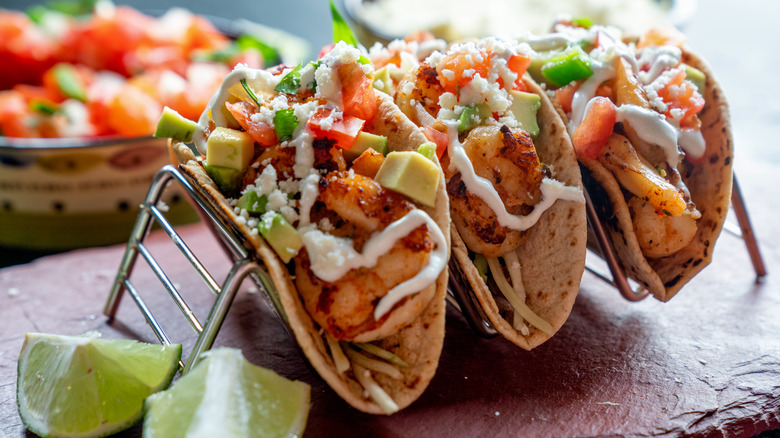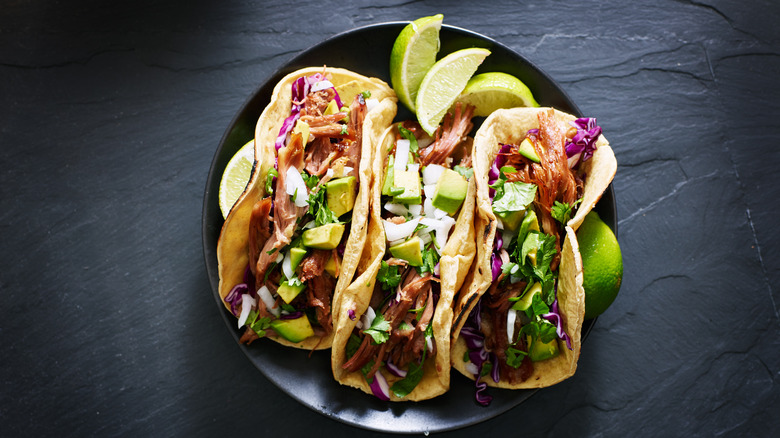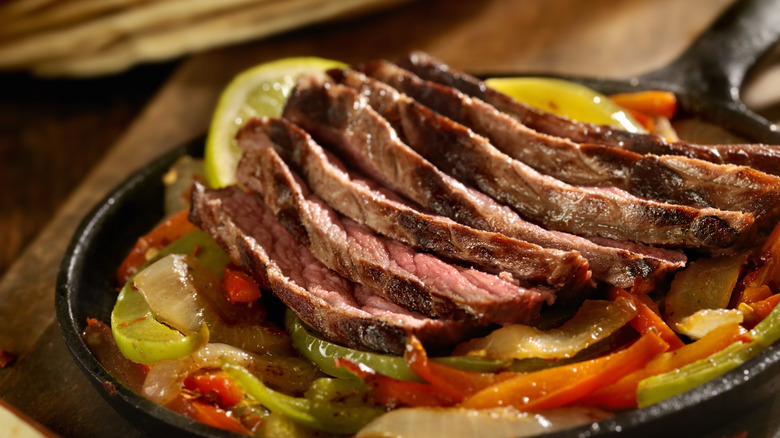What's The Difference Between Tacos And Fajitas?
Few dishes are as captivating to the imagination as tacos. What was the expression on your face when you read the word "taco?" Probably a smile. It's almost impossible to be unhappy when thinking about them. The same applies to fajitas, that sizzling dish you always see at Tex-Mex restaurants and wish you'd ordered. But wait ... isn't a fajita just a deconstructed taco? Well, not really.
Tacos and fajitas may seem conceptually similar, but while there's some overlap, they're distinct dishes. This is the genius of Mexican (and Mexican-inspired) cuisine: the ability to take the same basic components — tortilla, cheese, meat, vegetables — and through the power of both seasoning and creative cooking, create entirely new and unique dishes. Mexican (not to mention Tex-Mex) is a modular cuisine, capable of infinite customization. Tacos and fajitas are thus similar, sure — but the difference comes in how you cook the meat and vegetables.
Tacos are really modular
We don't know specifically where tacos were created. One theory is they came from Mexican silver miners, who named them after the sticks of dynamite used for excavation. We do know for certain that they're surprisingly recent: They likely came from the 18th century. But, since wrapping breadlike substances around meat, vegetables, and cheese seems to be a universal urge among global cuisines (witness how many different cultures feature some variety of dumplings), it was an idea just waiting for a mind to discover it. The strength of tacos lies in their versatility; you can do all sorts of things with tacos.
Regardless, the core concept is the same: A corn or wheat-based tortilla (sometimes hard, sometimes soft) small enough to be held in one hand is filled with meat, cheese, and vegetables and folded over. Those qualities sound like fajitas, but that's where you start to run into differences between the two. First of all, tacos are often a street food, but you're not going to see fajitas sold out of a stall. The bigger difference, though, is that with tacos, meat can come in tons of different styles, the vegetables are typically cut and served raw as a topping, and sauce is frequently present. Not so with fajitas.
Fajita meat is prepared a specific way
The first thing to understand is that, technically, tacos and fajitas don't originate from the same cuisine. Tacos are authentically Mexican, while fajitas are Tex-Mex — similar cuisines with overlapping influences, hence the names, but still distinct. However, the differences don't stop there. Obviously, the way they're typically served is different. Tacos come finished, while fajitas are assembled at the table, but that's not the true difference here.
In contrast to taco meat, fajita meat is always cut into strips — you're not typically going to get shredded meat fajitas. The meat is also usually cooked with the vegetables (most commonly peppers and onions), as opposed to separately. It's also much rarer to see hard-shell fajitas. The most similar thing about tacos and fajitas, though, is that you can prepare really good ones from the comfort of your home. Making tacos and fajitas doesn't require fancy technology or esoteric cooking techniques, just an eye for flavor and a willingness to experiment.


